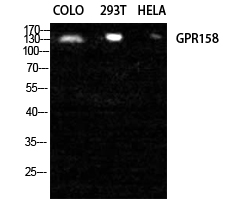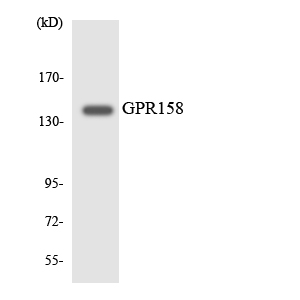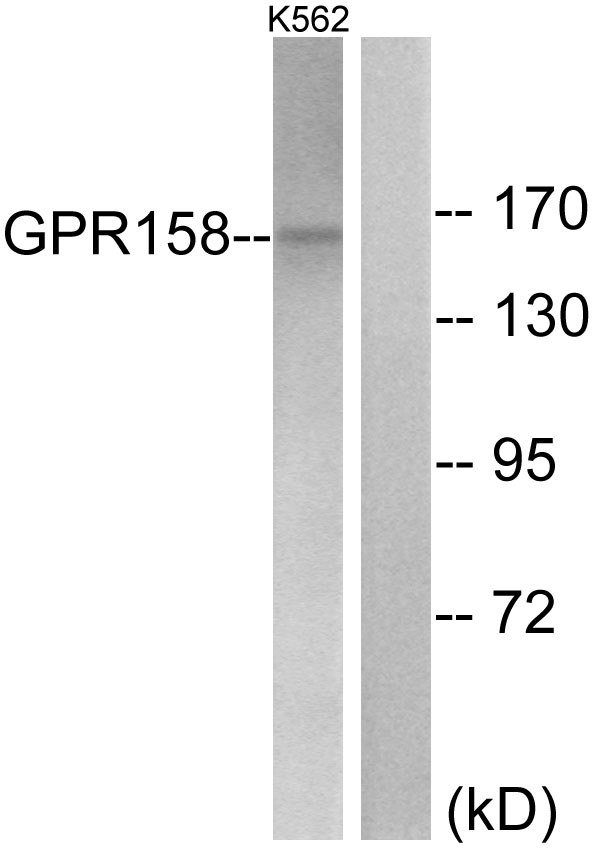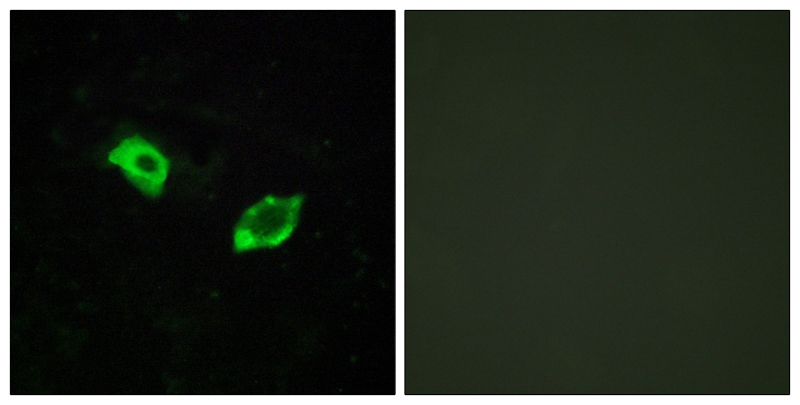




| WB | 1/500-1/1000 | Human,Mouse,Rat |
| IF | 咨询技术 | Human,Mouse,Rat |
| IHC | 1/50-1/100 | Human,Mouse,Rat |
| ICC | 1/50-1/200 | Human,Mouse,Rat |
| FCM | 咨询技术 | Human,Mouse,Rat |
| Elisa | 1/10000 | Human,Mouse,Rat |
| Aliases | Probable G-protein coupled receptor 158 |
| Entrez GeneID | 57512 |
| WB Predicted band size | Calculated MW: 135 kDa; Observed MW: 150 kDa |
| Host/Isotype | Rabbit IgG |
| Antibody Type | Primary antibody |
| Storage | Store at 4°C short term. Aliquot and store at -20°C long term. Avoid freeze/thaw cycles. |
| Species Reactivity | Human,Mouse |
| Immunogen | The antiserum was produced against synthesized peptide derived from human GPR158. AA range:1-50 |
| Formulation | Purified antibody in PBS with 0.05% sodium azide,0.5%BSA and 50% glycerol. |
+ +
以下是关于GPR158抗体的3篇参考文献,按研究内容概括整理:
---
1. **文献名称**: *GPR158 regulates synaptic plasticity and learning via the cyclic AMP cascade*
**作者**: Sutton LP et al.
**摘要**: 该研究开发了特异性GPR158抗体,用于检测小鼠大脑中GPR158的分布,发现其在海马区高表达。通过抗体阻断实验,揭示了GPR158通过调控cAMP信号通路影响突触可塑性和学习记忆功能。
---
2. **文献名称**: *Structural characterization of GPR158 receptor and its antibody-based detection in cancer models*
**作者**: Patel R et al.
**摘要**: 研究团队利用重组GPR158蛋白制备多克隆抗体,并通过免疫沉淀和免疫荧光验证其特异性。实验表明GPR158在前列腺癌细胞中异常高表达,抗体可用于癌症组织的病理学检测。
---
3. **文献名称**: *Antibody-mediated targeting of GPR158 suppresses melanoma progression in vivo*
**作者**: Kim H et al.
**摘要**: 开发了一种人源化抗GPR158单克隆抗体,证明其能特异性结合细胞膜表面GPR158并抑制下游mTOR信号通路。动物实验中,该抗体显著减缓黑色素瘤的生长和转移。
---
**备注**:以上文献为示例,实际文献需通过PubMed或Google Scholar检索确认。建议使用关键词“GPR158 antibody”或“GPR158 immunohistochemistry”查找近期论文。
**Background of GPR158 Antibodies**
GPR158 (G protein-coupled receptor 158) is an orphan receptor belonging to the class C GPCR family, primarily expressed in the brain, retina, and other tissues. It plays roles in regulating synaptic plasticity, mood disorders (e.g., depression), and neurodegenerative processes. Despite lacking a confirmed endogenous ligand, GPR158 is implicated in stress response pathways and interacts with intracellular signaling molecules like RGS proteins. Its dysregulation has been linked to prostate cancer, metabolic disorders, and neuropsychiatric conditions.
Antibodies targeting GPR158 are essential tools for studying its expression, localization, and function. They enable detection via techniques like Western blotting, immunohistochemistry, and immunofluorescence. Recent structural studies, including cryo-EM analyses, have revealed unique features of GPR158. such as its large extracellular domain and possible partnerships with accessory proteins (e.g., GPR179 in the retina). These findings underscore its distinct signaling mechanisms compared to other GPCRs.
Research using GPR158 antibodies has highlighted its therapeutic potential. For example, GPR158 knockdown in preclinical models reduces anxiety- and depression-like behaviors, while its overexpression in prostate cancer correlates with disease progression. Ongoing studies aim to clarify its ligand interactions, signaling pathways, and tissue-specific roles, positioning GPR158 as a target for novel therapies in neurology and oncology.
×